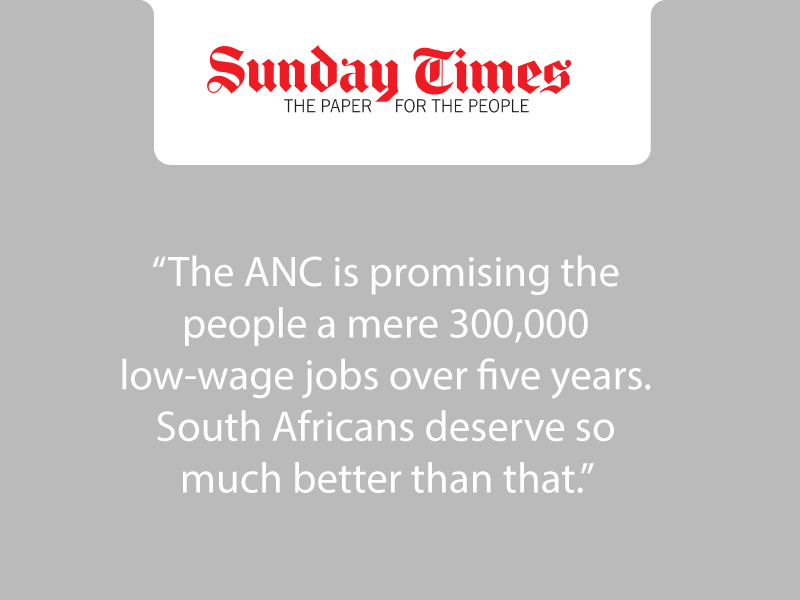
A lot of people seem to believe that white farmers and agri-processing corporations are getting in the way of land reform. This belief is starting to drive government and African National Congress policy.
The ANC has resolved to “discard market-driven land reform and immediately review the principle of willing-seller, willing-buyer so as to accelerate equitable distribution of land”. The Department of Land Affairs (DLA) is encouraging municipalities to levy very high rates on farm land to make it unaffordable for established farmers to stay on their land.
Parliament is considering an expropriation bill that will expand state powers to buy land at below market prices, without owners’ consent, and undermining owners’ access to the courts if they object to being expropriated.
Citing Zimbabwean and Namibian examples, the DLA has suggested that government should have the right of first refusal on all land outside developed urban areas and that without a certificate indicating government’s lack of “present interest”, such land cannot be sold on the open market.
But are established commercial farmers and agri-processing companies the real culprits?
The facts tell a different story.
It is simply incorrect to claim that “white farmers” or “the market” have been resisting land reform or manipulating prices upwards across the country. Market transactions have already transferred a quantity of land at least equivalent to 40% of that transferred through government’s land reform programmes. Just as important, the quality of land transferred through private market processes is higher than the average for all land transferred. And there has been no general “profiteering”. Across South Africa and on average, farm land was no more expensive in real terms in 2003 than it had been before land reform started in 1994. There is no evidence that prices are generally rising faster than average in areas where a great deal of land reform is taking place. There is also no consistent upward movement in the prices government has been paying to settle restitution claims.
It is equally wrong to imagine that agri-processing companies are opposed to land reform.
In the three major agri-business sectors studied (sugar, timber and fruit), the private sector has been actively engaged in promoting and supporting land reform for at least a decade. Two prominent examples are the sugar industry’s Inkezo Land Company, which has had a lot of success in redistributing sugar land and supporting emerging farmers, and Sappi’s deal with the Lereko Property Consortium, which has transferred 25% of Sappi’s forestry assets to broad-based black ownership.
There is overwhelming evidence that the outcomes of private-sector-led land reform have generally been good. This is because of the private sector’s emphasis on effective BEE rather than just on hectares transferred; its tighter focus on productivity and its better ability to allocate land for purpose to specific claimants and provide technical support to new farmers.
In the three years 2004 to 2007, state redistribution of formerly white-owned land to black owners has increased by less than half a percent, from 4,3% of commercial land to 4,7%. And, as the director-general of Land Affairs recently said, at least 50% of government land reform projects have failed to make their beneficiaries better off. Beneficiary communities and individual new farmers have often been left without post-settlement support. There have been several notorious disasters when restitution beneficiaries have been effectively abandoned by the government: the destruction on one set of formerly productive farms has been compared with a “war zone”.
Although the government has settled the majority of land claims it is struggling with the remaining some 5 000 claims. The last phase of restitution — dealing with the largest and most difficult rural claims — has resulted in large swathes of productive commercial land being placed under claim and therefore effectively frozen while the Land Claims Commission struggles to complete the process. For instance, according to the South African Cane Growers’ Association, 50% of all land planted with sugar cane is under claim, with only four percent settled by late 2007.
So what are the real problems?
First, there is a deepening lack of capacity within provincial and national state structures to engage constructively with private interests, manage post-settlement support or even spend the money allocated to land reform by the treasury. Around a third of posts, including senior positions, in the DLA are vacant. Many officials know little about the realities of agriculture.
As a result, numerous reports from established farmers and agri-business all sound the same. For years they struggle to form partnerships with government structures and resolve land issues voluntarily, often making generous offers of land and ongoing post-settlement support. These offers are rejected and eventually land is bought by the government. But officials somehow do not get round to allocating the land to beneficiaries and it lies fallow and deteriorating for years. Or they fail to appreciate that agriculture is a seasonal business and move people on to land at the wrong time of year. When land is eventually allocated, beneficiaries receive no support from government. Large-scale agri-businesses report similar kinds of problems: the vast extent and slow processing of claims is a key obstacle to both the sugar and timber industries, and we are already beginning to see signs that large agri-processors are shifting their operations to other countries.
Second, there is a serious mismatch between the tasks assigned to the DLA and its budget. In 2008/9, the DLA’s total budget was R6,6 billion. To put this amount in perspective, just a handful of claims on valuable coastal land could cost R1 billion to settle.
South Africa cannot afford to stay on the current path. Progress is stalled and policy trends are negative. Dissatisfaction is rising on all sides.
We urgently need to find a new way forward. This must be based on an accurate understanding of what is really getting in the way of successful land reform.
The country should immediately establish a talented, action-oriented partnership which will report every six months to Parliament on progress with respect to land issues. This partnership should consist of senior leaders in government, the ruling party and the private sector with specific priorities relating to restitution, redistribution, commercial agriculture and addressing rural poverty more directly.
This partnership will need to transform the increasingly problematic language in which land reform is discussed. We need to move away from misleading Zimbabwe-style terminology and away from unhelpful, ill-informed debates about the role of the market or the concept of ‘willing seller-willing buyer’ (which has never applied to restitution in any case). We need to move towards concepts such as co-operative relationships between state and market to maximise available capacity, sustainable development, escaping rural poverty, expanding educational and economic opportunity.
There is no doubt that a country which negotiated its entire political structure only 14 years ago can negotiate a new deal on land reform. The key question is whether leadership in the public and private sectors has the will to get land reform back on track.




